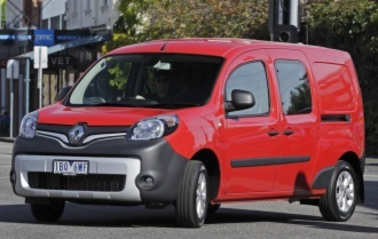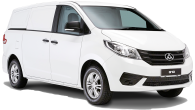It is an odd sensation to drive a van that makes hardly any noise. Vans normally have diesel engines and commercial diesels usually aren't very quiet. But this van doesn't have a diesel engine.
In fact, it doesn't have an engine at all. The Renault Kangoo I am driving along a busy road in Melbourne has an electric motor. It's called the ZE, for zero emissions, and this one is a demonstration van Renault has brought to Australia to try to show us that electric commercial vehicles could make sense now, not just at some stage in the far-off future.
So, what does driving an electric van feel like? Well, if you've ever driven an electric golf kart you'll have the basic idea. Not that the ZE Kangoo is as slow or as basic as a golf kart but there are similarities.
You press the accelerator, it moves away quickly. It drives directly - there is no gearbox to create step changes - so the van simply accelerates until it reaches your desired cruising speed. Contrary to what you might expect, this is no Noddy mobile and can theoretically reach 130km/h.
That said, it doesn't accelerate in a way that could ever be described as rapid. It takes about 20 seconds to make it from rest to 100km/h. The upside is that the electric motor delivers its maximum torque, some 220Nm, the moment you press down on the accelerator.
This means you get away swiftly from a stop and have no problem keeping up with traffic, even when everyone is in a big hurry. The ZE has a lithium-ion battery pack, using the same technology as the latest portable power tools, and it has a capacity of 22kW/h.
For reference, this author's small home solar panel system produces about 10kW/h on a really sunny day. The range is going to depend on the driving conditions, whether you're driving it like you stole it, whether the aircon is working hard all day and whether you are driving it on the flat or going up and down like a roller-coaster.
Renault says that most drivers can expect a range of somewhere between 80km and 120km from a fully charged battery. Charging the battery takes six to nine hours.
Inside, the ZE looks like any other Kangoo except for a different instrument cluster, which no longer needs a tacho. The test van is a regular cargo model but in Europe it can be ordered in a larger Maxi format with two seats and a Maxi crew-seater that carries five people.
It moves along like any other Kangoo, although it is about 160kg heavier for a total weight of 1426kg. The battery pack is neatly packaged beneath the cargo floor, so there is no imposition on the cargo area. The extra weight of the batteries reduces the payload to 650kg.
Australia Post is currently testing the practicality of the Renault. The company, which is pushing hard with electric bicycles for some of its mail runs, is running four Kangoo ZE models in its fleet. It will run them for a year, taking note of how the vans perform and whether the reduced range and recharging time is a problem.
Australia Post will also be able to work out whether running electric vans makes business sense. Renault was not about to disclose how much a ZE van costs but it is likely to be two or three times the standard price of the van, which can be bought for $19,990 with a regular combustion engine.
Renault Kangoo 2014: Maxi
| Engine Type | Diesel Turbo 4, 1.5L |
|---|---|
| Fuel Type | Diesel |
| Fuel Efficiency | 5.2L/100km (combined) |
| Seating | 2 |
| Price From | $8,690 - $12,210 |
Verdict
Renault has no plan to introduce the ZE Kangoo as a regular model here but that could all change if a big customer such as Australia Post wants a fleet of them. As with all of these new technologies, prices tend to fall as production rates increase.
Pricing Guides

Range and Specs
| Vehicle | Specs | Price* |
|---|---|---|
| 1.6 SWB | 1.6L, 4 SPEED AUTOMATIC | $9,680 - $13,310 |
| Maxi | 1.5L, Diesel, 6 SPEED MANUAL | $9,680 - $13,200 |
| Maxi Crew | 1.5L, Diesel, 6 SPEED MANUAL | $9,240 - $13,090 |


.jpg)
.jpg)
.jpg)
.jpg)
.jpg)
.jpg)

.jpg)




.jpg)
-W.jpg)




.jpg)
.jpg)
Comments